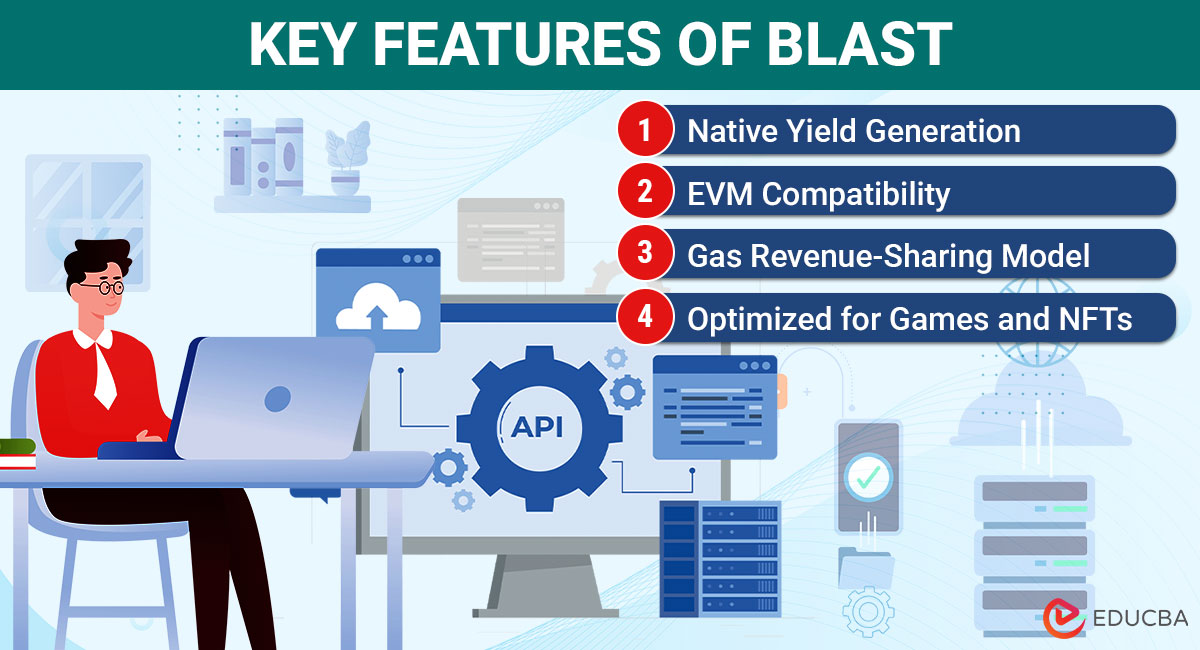
Blast RPC API: Overview
Blast is an Ethereum Layer 2 (L2) scaling solution that offers a more efficient way to interact with the Ethereum blockchain. It helps address
Ethereum’s scalability issues by enabling faster and cheaper transactions. In this guide, we will look at how developers can use the Blast RPC
API to power their decentralized applications (dApps).
What is Blast, and Why is it Important?
Blast is an Ethereum L2 protocol that uses optimistic rollups to handle transactions off-chain and later batches them onto the Ethereum
mainnet. This process reduces transaction fees and increases throughput, making it ideal for scaling decentralized applications (dApps).
Key Features of Blast:
- Native yield generation: Blast allows users to earn a 4% yield on ETH and 5% on stablecoins, providing a passive income stream through ETH staking and Real-World Asset (RWA) protocols.
- EVM compatibility: It is fully compatible with the Ethereum Virtual Machine (EVM), meaning developers can deploy existing dApps without making code changes.
- Gas revenue-sharing model: Unlike other Layer 2 solutions, Blast shares gas revenue with developers, creating new business opportunities.
- Optimized for games and NFTs: Blast’s high-performance infrastructure makes it well-suited for gaming platforms and NFT projects, where low fees and quick transactions are crucial.
What is a Blast Node?
A Blast node is a key part of the Blast L2 network. It validates transactions, ensures network consensus, and maintains the blockchain state.
Blast nodes use optimistic rollup technology, where transactions are presumed valid unless proven otherwise. This allows faster processing
times and reduces costs.
How to Use the Blast RPC API to Get Blockchain Data?
With the Blast API, developers can access various blockchain data points, such as transaction information, block details, and account
balances. The API is compatible with standard Ethereum JSON-RPC methods, making it easy for developers to integrate into their existing
systems.
Common RPC Methods Supported by Blast:
- eth_blockNumber: Fetches the latest block number on the Blast network.
- eth_getBalance: Retrieves the balance of a specific address.
- eth_getTransactionByHash: Fetches transaction details using the transaction hash.
- eth_getLogs: Gets event logs based on specific filters.
You can make HTTP requests to the Blast RPC API endpoint using tools like cURL or integrate the API directly into your application with libraries like Web3.js in various programming languages.
How to Set Up Your Own Blast RPC Node?
For developers who prefer to run their own Blast RPC API node, here is how to set it up:
1. Hardware Requirements
To run a Blast RPC node efficiently, your machine should meet these specifications:
- CPU: 4+ cores
- RAM: 16GB+
- Storage: 1TB+ SSD (NVMe recommended for better performance)
- Network: Stable internet with at least 10 Mbps upload/download speeds
2. Software Installation
Follow these steps to set up your Blast RPC API node:
- Install a compatible OS: Use Ubuntu 20.04 LTS or another suitable Linux distribution.
- Install Docker and Docker Compose: These tools allow you to manage and deploy containers easily.
- Clone the Blast node repository: Get the official node repository from the Blast GitHub page.
- Configure the node: Set up configuration files to define your node’s settings.
- Start the node: Run the node using Docker Compose.
3. Ongoing Maintenance
Once your Blast RPC API node is running, it is important to maintain it:
- Regular software updates: Ensure your node is always running the latest version.
- Monitor system performance: Monitor resources like disk space, CPU, and RAM usage.
- Security: Implement security measures to protect your node from potential attacks.
Using the Blast RPC API from a Provider
Running your Blast RPC API node can be resource-intensive, so many developers use a provider like GetBlock. These providers handle the
infrastructure and maintenance, allowing you to focus on developing your dApp or building trading bots.
How to Get the Blast RPC API:
- Sign up: Go to GetBlock and create an account.
- Get the API key: After signing up, you will get an API key that gives you access to the Blast RPC API.
- Start using the API: Use the provided API key to integrate Blast data into your applications without the hassle of managing infrastructure.
Final Thoughts
The Blast RPC API is a powerful tool for developers looking to build on Ethereum’s Layer 2 network. Whether you run your own node or use a provider like GetBlock, the Blast RPC API enables you to efficiently access blockchain data for your dApps, trading bots, or other Web3 projects.
By leveraging Blast’s features, such as yield generation and optimized scalability for gaming and NFT applications, you can take advantage of Ethereum’s growing ecosystem with lower costs and faster transaction speeds.
Recommended Articles
We hope this article helped you understand how the Blast RPC API can enhance your dApp performance on Ethereum Layer 2. Explore these recommended articles to dive deeper into blockchain development, optimize your Web3 tools, and stay updated with the latest in Layer 2 solutions.
